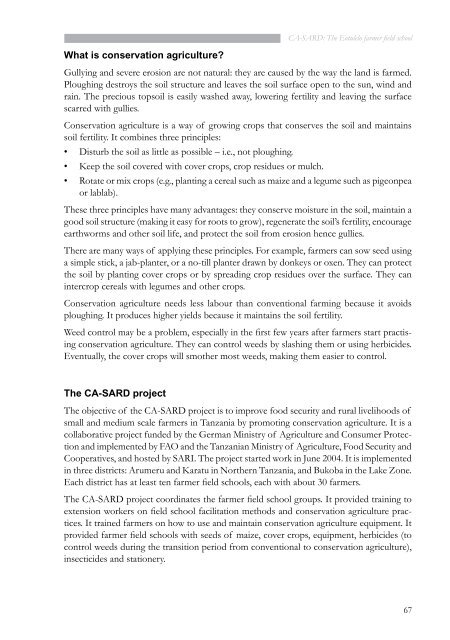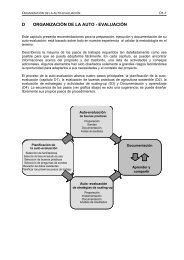cases from tanzania - Sustainet
cases from tanzania - Sustainet
cases from tanzania - Sustainet
You also want an ePaper? Increase the reach of your titles
YUMPU automatically turns print PDFs into web optimized ePapers that Google loves.
what is conservation agriculture?<br />
CA-SARD: The Eotulelo farmer field school<br />
Gullying and severe erosion are not natural: they are caused by the way the land is farmed.<br />
Ploughing destroys the soil structure and leaves the soil surface open to the sun, wind and<br />
rain. The precious topsoil is easily washed away, lowering fertility and leaving the surface<br />
scarred with gullies.<br />
Conservation agriculture is a way of growing crops that conserves the soil and maintains<br />
soil fertility. It combines three principles:<br />
• Disturb the soil as little as possible – i.e., not ploughing.<br />
• Keep the soil covered with cover crops, crop residues or mulch.<br />
• Rotate or mix crops (e.g., planting a cereal such as maize and a legume such as pigeonpea<br />
or lablab).<br />
These three principles have many advantages: they conserve moisture in the soil, maintain a<br />
good soil structure (making it easy for roots to grow), regenerate the soil’s fertility, encourage<br />
earthworms and other soil life, and protect the soil <strong>from</strong> erosion hence gullies.<br />
There are many ways of applying these principles. For example, farmers can sow seed using<br />
a simple stick, a jab-planter, or a no-till planter drawn by donkeys or oxen. They can protect<br />
the soil by planting cover crops or by spreading crop residues over the surface. They can<br />
intercrop cereals with legumes and other crops.<br />
Conservation agriculture needs less labour than conventional farming because it avoids<br />
ploughing. It produces higher yields because it maintains the soil fertility.<br />
Weed control may be a problem, especially in the first few years after farmers start practising<br />
conservation agriculture. They can control weeds by slashing them or using herbicides.<br />
Eventually, the cover crops will smother most weeds, making them easier to control.<br />
the cA-sArD project<br />
The objective of the CA-SARD project is to improve food security and rural livelihoods of<br />
small and medium scale farmers in Tanzania by promoting conservation agriculture. It is a<br />
collaborative project funded by the German Ministry of Agriculture and Consumer Protection<br />
and implemented by FAO and the Tanzanian Ministry of Agriculture, Food Security and<br />
Cooperatives, and hosted by SARI. The project started work in June 2004. It is implemented<br />
in three districts: Arumeru and Karatu in Northern Tanzania, and Bukoba in the Lake Zone.<br />
Each district has at least ten farmer field schools, each with about 30 farmers.<br />
The CA-SARD project coordinates the farmer field school groups. It provided training to<br />
extension workers on field school facilitation methods and conservation agriculture practices.<br />
It trained farmers on how to use and maintain conservation agriculture equipment. It<br />
provided farmer field schools with seeds of maize, cover crops, equipment, herbicides (to<br />
control weeds during the transition period <strong>from</strong> conventional to conservation agriculture),<br />
insecticides and stationery.<br />
67




